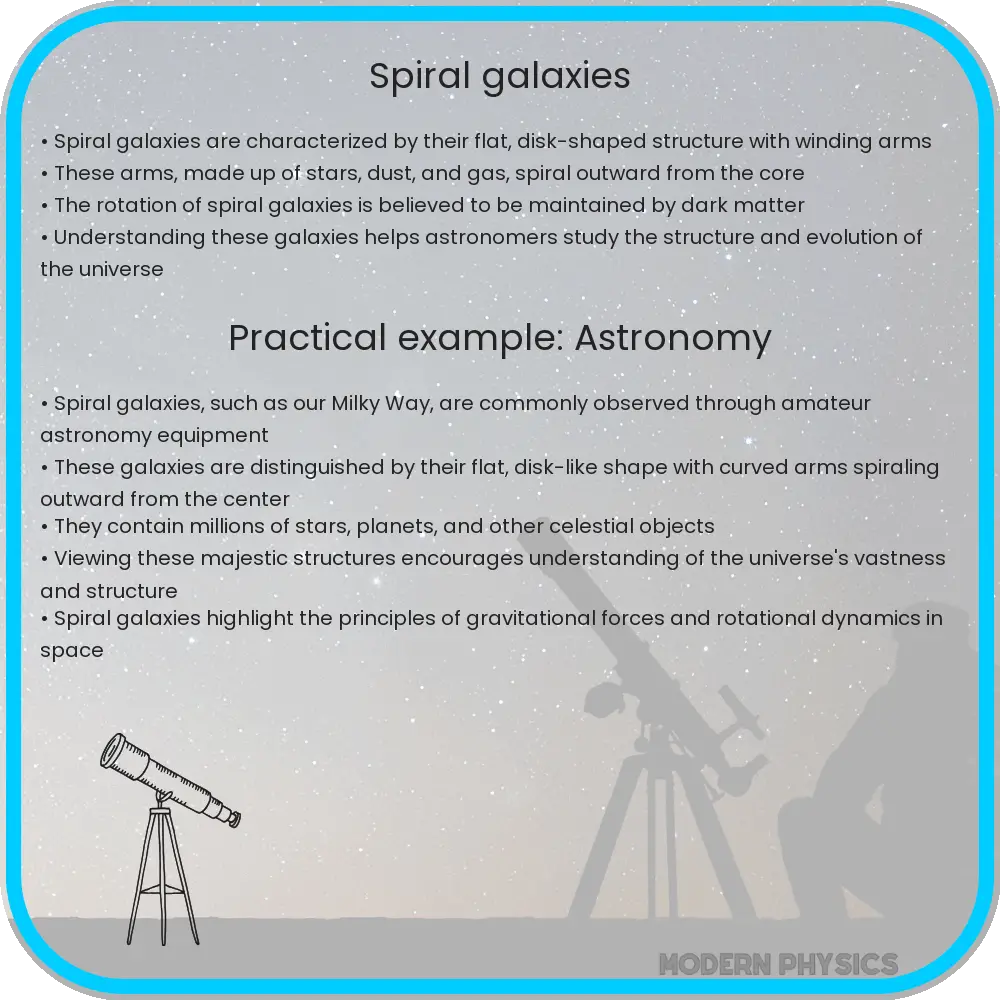Explore the formation, structure, and evolution of spiral galaxies, from their swirling arms to the impact of dark matter and black holes on their development.

Understanding Spiral Galaxies
Spiral galaxies, characterized by their distinct swirling arms radiating from a central nucleus, represent one of the most picturesque structures in the universe. These celestial entities are not only stunning to behold but are also crucial in understanding the cosmos’ formation, structure, and evolution. This article delves into the intricacies of spiral galaxies, shedding light on their formation, structure, and the processes driving their continuous evolution.
Formation of Spiral Galaxies
The formation of spiral galaxies remains a topic of intense astronomical research. The leading hypothesis suggests they originate from the gravitational collapse of slightly rotating clouds of interstellar gas and dust. Over time, these clouds, influenced by dark matter, begin to flatten and spin due to conservation of angular momentum, gradually morphing into a disk-like structure with a central bulge. This process, while still not entirely understood, outlines the basic framework for the birth of spiral galaxies.
Structure of Spiral Galaxies
A typical spiral galaxy comprises several key components: the central bulge, the disk, and the halo. The central bulge is a dense, spherical structure made up of older stars, which lacks the gas and dust necessary for new star formation. Surrounding the bulge is the disk, characterized by its flat, circular shape and composed of younger stars, gas, and dust. This region is notable for its striking spiral arms, where active star formation occurs. Lastly, the halo surrounds the galaxy, containing old stars, globular clusters, and dark matter, extending far beyond the visible edge of the galaxy.
Evolution of Spiral Galaxies
The evolution of spiral galaxies is a complex process influenced by various factors, including star formation, gravitational interactions, and the accretion of gas. As galaxies rotate, the spiral arms act as wave patterns, compressing gas and dust and triggering new star formation. Over billions of years, these processes, combined with interactions with other galaxies, can significantly alter a galaxy’s appearance and structure, leading to the fascinating diversity observed in the cosmos.
Galactic Interactions and Their Impact
Interactions between spiral galaxies play a pivotal role in their evolution. These encounters can range from minor flybys to full-blown mergers. During such events, gravitational forces can distort the galaxies’ shapes, leading to the formation of new structures such as ring galaxies, tidal tails, and even elliptical galaxies if the merger is significant enough. The Milky Way itself is on a collision course with the Andromeda galaxy, promising a dramatic transformation over the next few billion years.
Role of Dark Matter and Black Holes
Dark matter, though invisible and not directly observable, is believed to constitute a significant portion of a galaxy’s mass. It plays a crucial role in the formation and stability of spiral galaxies by affecting their gravitational pull. Additionally, at the heart of most spiral galaxies lies a supermassive black hole, influencing the dynamics of the central regions and possibly regulating star formation through its energetic emissions.
Future of Spiral Galaxies
The future of a spiral galaxy depends on various factors including its mass, environment, and the rate of star formation. Over time, the depletion of interstellar gas can slow down the rate of new star formation, leading to an aging population of stars. Furthermore, environmental factors like nearby galaxies can strip away gas, affecting the galaxy’s ability to form new stars.
Conclusion
Spiral galaxies are dynamic entities that encapsulate the beauty and complexity of the universe. From their formation from vast clouds of gas and dust to their evolution driven by internal and external forces, these celestial structures continue to fascinate astronomers and laypeople alike. The study of spiral galaxies not only enriches our understanding of cosmic phenomena but also provides insights into the history and future of our own galaxy. As technology and astronomical tools advance, we can anticipate unraveling more mysteries surrounding these spiral wonders, further deepening our knowledge of the cosmos.
